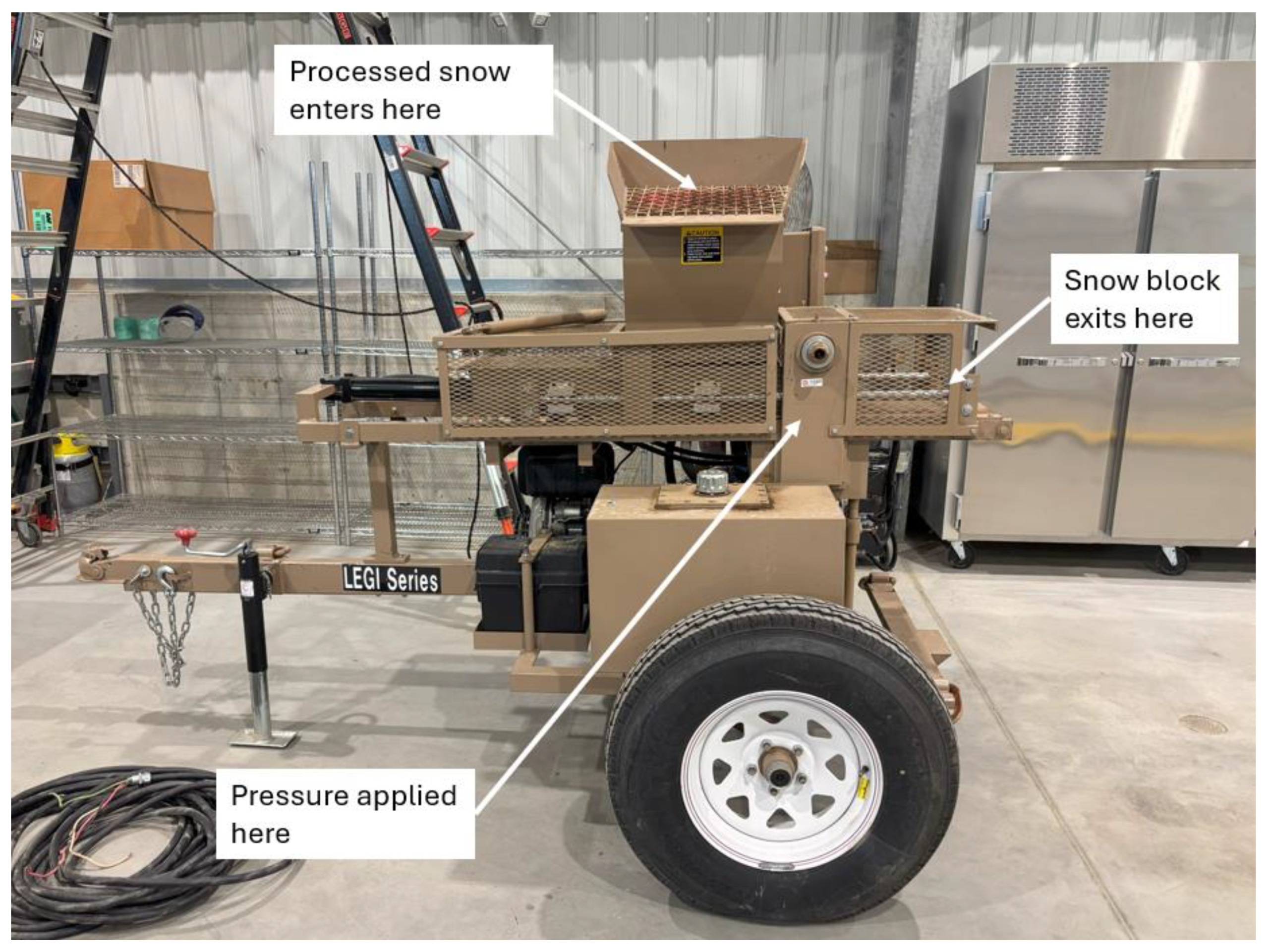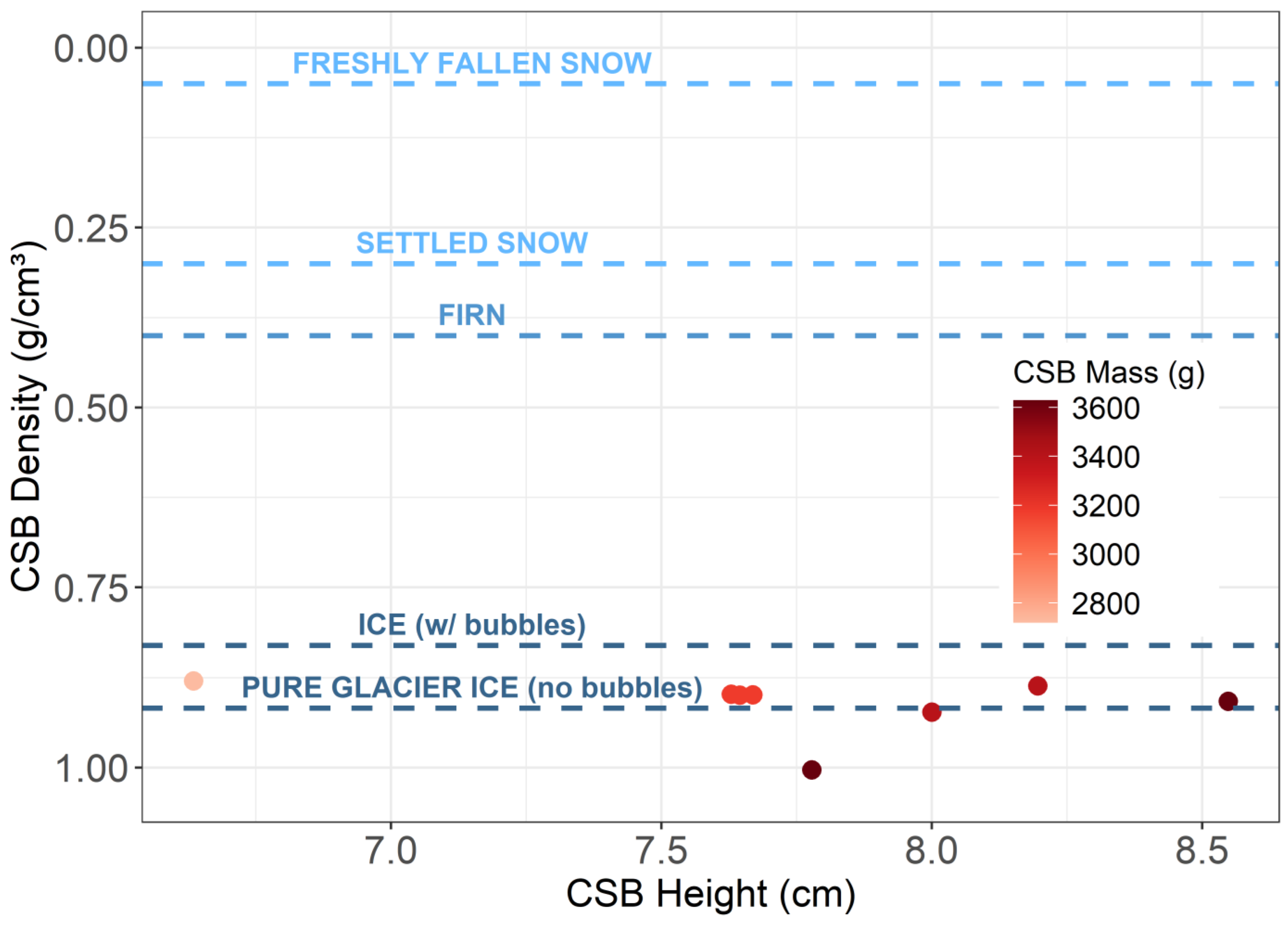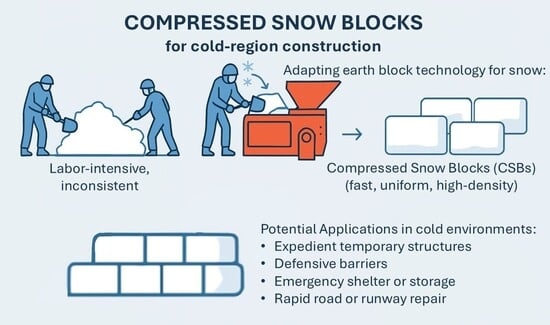Compressed Snow Blocks: Evaluating the Feasibility of Adapting Earth Block Technology for Cold Regions
Abstract
1. Introduction
2. Materials and Methods
2.1. CEB Machine
2.2. Snow Collection and Processing
2.3. CSB Production
3. Results
3.1. Block Properties and Consistency
3.2. Visual Characteristics
4. Discussion
4.1. Sources of Block Variability and Potential Impacts
4.2. Implications of Density for Strength
4.3. Design Optimization and Future Development
5. Conclusions
Author Contributions
Funding
Institutional Review Board Statement
Informed Consent Statement
Data Availability Statement
Acknowledgments
Conflicts of Interest
Abbreviations
| AECT | Advanced Earthen Construction Technologies |
| CEB | Compressed Earth Block |
| CRREL | Cold Regions Research and Engineering Laboratory |
| CSB | Compressed Snow Block |
| ERDC | Engineer Research and Development Center |
| GSL | Geotechnical and Structures Laboratory |
References
- Mellor, M. Engineering properties of snow. J. Glaciol. 1977, 19, 15–66. [Google Scholar] [CrossRef]
- Ryynänen, K. Handbook of Snow and Ice Construction; Publications of Lapland University of Applied Science: Rovaniemi, Finland, 2025; Available online: https://www.theseus.fi/handle/10024/896871 (accessed on 10 October 2025).
- White, G.; McCallum, A. Review of ice and snow runway pavements. Int. J. Pavement Res. Technol. 2017, 11, 311–320. [Google Scholar] [CrossRef]
- Kershaw, P.G.; Scott, P.A.; Welch, H.E. The Shelter Characteristics of Traditional-Styled Inuit Snow Houses. Arct. Inst. N. Am. 1996, 49, 328–338. [Google Scholar] [CrossRef]
- Sun, J.; Zhang, Q.; Zhang, G.; Fan, F. Building with Snow: Technical Exploration and Practice of Snow Materials and Snow Architecture. Buildings 2025, 15, 1277. [Google Scholar] [CrossRef]
- Blaisdell, G.L.; Melendy, T.D.; Blaisdell, M.N. Ballistic protection using snow. Int. J. Impact Eng. 2021, 155, 103903. [Google Scholar] [CrossRef]
- Haehnel, R.B.; Blaisdell, G.L.; Melendy, T.D.; Shoop, S.; Courville, Z. A Snow Runway for Supporting Wheeled Aircraft; Technical Report TR-19-4; US Army ERDC-CRREL: Vicksburg, MS, USA, 2019. [Google Scholar] [CrossRef]
- Wang, E.; Fu, X.; Han, H.; Liu, X.; Xiao, Y.; Leng, Y. Study on the Mechanical Properties of Compacted Snow Under Uniaxial Compression and Analysis of Influencing Factors. Cold Reg. Sci. Technol. 2021, 182, 103215. [Google Scholar] [CrossRef]
- Carruth, W.D.; Melendy, T.D.; Blaisdell, G.L.; Watts, B.E.; Kennedy, D.E.; Tingle, J.S.; Bianchini, A. Extreme Cold Weather Airfield Damage Repair Testing at Goose Bay Air Base, Canada; Technical Report TR-24-3; US Army ERDC-CRREL: Vicksburg, MS, USA, 2024. [Google Scholar]
- Zami, M.S.; Lee, A. Economic Benefits of Contemporary Earth Construction in Low-Cost Urban Housing—State of the Art Review. J. Build. Apprais. 2010, 5, 259–271. [Google Scholar] [CrossRef]
- Aranda-Jiménez, Y.; Zuñiga-Leal, C.; Moreno-Chimely, L.; Robles-Aranda, M.E. Compressed Earth Blocks (CEB) Compression Testing Under Two Earth Standards. Cogent Eng. 2023, 10, 2163116. [Google Scholar] [CrossRef]
- Burroughs, J.F.; Rushing, T.S.; Rusche, C.P. A Comparison of Automated and Semi-Automated Compressed Earth Block Presses Using Natural and Stabilized Soils. In Proceedings of the 2015 Conference on Autonomous and Robotic Construction of Infrastructure, Ames, IA, USA, 2–3 June 2015; pp. 47–55. [Google Scholar]
- Guillaud, H.; Guillaud, H.; Joffroy, T.; Odul, P. Compressed Earth Blocks: Manual of Design and Construction; Vieweg: Eschborn, Germany, 1985; Volume 2, Available online: http://ndl.ethernet.edu.et/bitstream/123456789/32596/1/6.pdf (accessed on 10 October 2025).
- Hema, C.; Messan, A.; Lawane, A.; Van Moeseke, G. Impact of the Design of Walls Made of Compressed Earth Blocks on the Thermal Comfort of Housing in Hot Climate. Buildings 2020, 10, 157. [Google Scholar] [CrossRef]
- Advanced Earthen Construction Technologies (AECT). Impact 2001A Series. Available online: https://aectearthblock.com/impact-2001a-series (accessed on 6 November 2025).
- Headquarters, Department of the Army. Basic Cold Weather Manual; Field Manual FM 31-70; Department of the Army: Washington, DC, USA, 1968. [Google Scholar]
- Sun, L.; Zhang, X.; Wang, H.; Xiao, P.; Wang, Y. Estimating daily snow density through a spatiotemporal random forest model. Water Resour. Res. 2024, 60, e2023WR036942. [Google Scholar] [CrossRef]
- Pomeroy, J.W.; Brun, E. Chapter 2: Physical Properties of Snow. In Snow Ecology: An Interdisciplinary Examination of Snow-Covered Ecosystems; The Press Syndicate of the University of Cambridge: Cambridge, UK, 2001; pp. 45–126. [Google Scholar]
- Rushing, T.S.; Burroughs, J.F.; Rusche, C.P. Evaluation of Stabilization Approaches for Compressed Earth Blocks; unpublished work; US Army ERDC-GSL: Vicksburg, MS, USA, 2014. [Google Scholar]
- Cuffey, K.M.; Paterson, W.S.B. The Physics of Glaciers, 4th ed.; Academic Press: Cambridge, MA, USA, 2010; Available online: https://shop.elsevier.com/books/the-physics-of-glaciers/cuffey/978-0-12-369461-4 (accessed on 10 October 2025).
- Russell-Head, D.; Budd, W.; Moore, P. Compacted snow as a pavement material for runway construction. Cold Reg. Sci. Technol. 1984, 9, 231–247. [Google Scholar] [CrossRef]
- Abele, G.; Frankenstein, G. Snow and Ice Properties as Related to Roads and Runways in Antarctica; Technical Report TR-176; US Army ERDC-CRREL: Vicksburg, MS, USA, 1967. [Google Scholar]
- Abele, G. Deformation of Snow Under Rigid Plates at a Constant Rate of Penetration; Research Report 273; US Army ERDC-CRREL: Vicksburg, MS, USA, 1970. [Google Scholar]
- Abele, G.; Gow, A.J. Compressibility Characteristics of Undisturbed Snow; Research Report 76-21; US Army ERDC-CRREL: Vicksburg, MS, USA, 1976. [Google Scholar]
- Zhang, Y.; Guo, J.; Zhu, Y.; Chen, S.; Gao, C.; Sun, R.; Wang, Y. Snow resource reutilization: Design of snow collection and compression equipment based on functional analysis method. Sustainability 2024, 16, 9564. [Google Scholar] [CrossRef]
- Runge, R.; Advanced Earthen Construction Technologies (AECT), San Antonio, TX, USA. Personal communication, 2025.
- Martoïa, F.; Cochereau, T.; Dumont, P.; Orgéas, L.; Terrien, M.; Belgacem, M. Cellulose nanofibril foams: Links between ice-templating conditions, microstructures and mechanical properties. Mater. Des. 2016, 104, 376–391. [Google Scholar] [CrossRef]
- Golovin, Y.I.; Rodaev, V.V.; Samodurov, A.A.; Tyurin, A.I.; Golovin, D.Y.; Vasyukov, V.M.; Razlivalova, S.S.; Buznik, V.M. Strengthening of Ice Composites with Cellulose and Inorganic Nanoparticles. Nanobiotechnol. Rep. 2023, 18, 371–383. [Google Scholar] [CrossRef]
- Maki, L.R.; Galyan, E.L.; Chang-Chien, M.; Caldwell, D.R. Ice Nucleation Induced by Pseudomonas syringae. Appl. Microbiol. 1974, 28, 456–459. [Google Scholar] [CrossRef] [PubMed]





| Block ID | Block Height (cm) | Block Mass (g) | Block Density (g/cm3) |
|---|---|---|---|
| A | 6.67 | 2721.55 | 0.88 |
| B | 7.62 | 3175.14 | 0.90 |
| C | 7.62 | 3175.14 | 0.90 |
| D | 7.62 | 3175.14 | 0.90 |
| E | 7.78 | 3628.74 | 1.00 |
| F | 7.94 | 3401.94 | 0.92 |
| G | 8.26 | 3401.94 | 0.89 |
| H | 8.57 | 3628.74 | 0.91 |
Disclaimer/Publisher’s Note: The statements, opinions and data contained in all publications are solely those of the individual author(s) and contributor(s) and not of MDPI and/or the editor(s). MDPI and/or the editor(s) disclaim responsibility for any injury to people or property resulting from any ideas, methods, instructions or products referred to in the content. |
© 2025 by the authors. Licensee MDPI, Basel, Switzerland. This article is an open access article distributed under the terms and conditions of the Creative Commons Attribution (CC BY) license (https://creativecommons.org/licenses/by/4.0/).
Share and Cite
Duggan DiDominic, K.L.; Melendy, T.D., Jr.; Charlebois, C.M. Compressed Snow Blocks: Evaluating the Feasibility of Adapting Earth Block Technology for Cold Regions. Glacies 2025, 2, 14. https://doi.org/10.3390/glacies2040014
Duggan DiDominic KL, Melendy TD Jr., Charlebois CM. Compressed Snow Blocks: Evaluating the Feasibility of Adapting Earth Block Technology for Cold Regions. Glacies. 2025; 2(4):14. https://doi.org/10.3390/glacies2040014
Chicago/Turabian StyleDuggan DiDominic, Katie L., Terry D. Melendy, Jr., and Chrestien M. Charlebois. 2025. "Compressed Snow Blocks: Evaluating the Feasibility of Adapting Earth Block Technology for Cold Regions" Glacies 2, no. 4: 14. https://doi.org/10.3390/glacies2040014
APA StyleDuggan DiDominic, K. L., Melendy, T. D., Jr., & Charlebois, C. M. (2025). Compressed Snow Blocks: Evaluating the Feasibility of Adapting Earth Block Technology for Cold Regions. Glacies, 2(4), 14. https://doi.org/10.3390/glacies2040014








